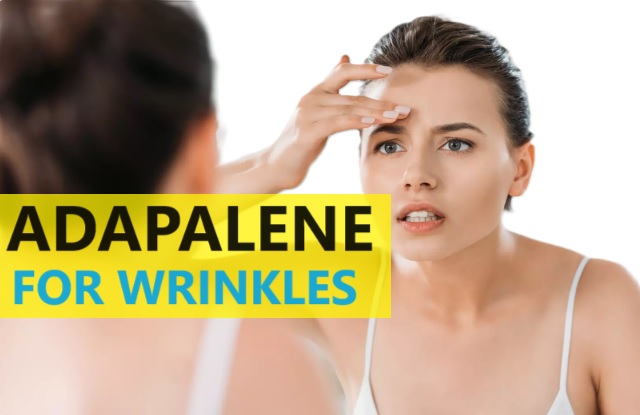
Adapalene For Wrinkles, Benefits, How to use and Side Effects: Unlike some other retinoids, adapalene is available in both prescription and over-the-counter formulations, making it accessible to a wide range of individuals seeking to rejuvenate their skin. Its mechanism of action involves promoting skin cell turnover, unclogging pores, and improving the overall texture and appearance of the skin. This makes adapalene a promising option for those looking to combat the effects of aging on their skin.
Here you will learn the science behind adapalene, its mechanisms of action, and its proven benefits for wrinkle reduction. Additionally, it will offer practical guidance on how to use adapalene effectively and safely, addressing common concerns and misconceptions.
What is Adapalene?
Adapalene is a synthetic retinoid and a derivative of vitamin A that has garnered attention in the world of dermatology and skincare. It belongs to the class of topical medications known as retinoids, renowned for their skin-transforming properties. Adapalene is approved by the FDA for the treatment of acne but has recently gained recognition for its potential in addressing signs of aging, such as wrinkles and fine lines.
The use of adapalene for wrinkles has been a subject of increasing interest within the skincare and dermatological communities. This interest is fueled by several factors, including its proven efficacy in addressing acne, its relatively mild side effect profile, and its potential to enhance skin quality.
Adapalene’s ability to stimulate collagen production and improve skin elasticity has led to its exploration as an anti-aging solution. As individuals seek non-invasive and scientifically supported methods to combat the visible signs of aging, the versatility and accessibility of adapalene have made it a promising option.
Causes and Types of Wrinkles
Wrinkles are a natural part of the aging process, resulting from various factors such as genetics, sun exposure, and lifestyle choices. There are two primary types of wrinkles:
Intrinsic Wrinkles: These are often referred to as “expression lines” and develop as a result of repetitive facial muscle movements over time. Common examples include forehead lines, crow’s feet, and smile lines.
Extrinsic Wrinkles: These wrinkles are primarily caused by external factors, with UV radiation from the sun being a leading contributor. Other factors include smoking, pollution, and poor skincare practices.
Role of Collagen and Elastin
Collagen and elastin are essential proteins that provide the skin with its structure, firmness, and elasticity. As we age, the production of these proteins decreases, leading to a breakdown of the skin’s support network. This process leads to skin sagging and the formation of wrinkles.
Collagen: Collagen provides the skin with its structural integrity and suppleness. Reduced collagen production contributes to the loss of skin firmness and the appearance of fine lines and wrinkles.
Elastin: Elastin is responsible for the skin’s ability to stretch and bounce back. Decreased elastin levels result in less skin elasticity, making it prone to wrinkles and sagging.
How Adapalene Works on Wrinkles?
Adapalene is a dermatological powerhouse that has gained immense recognition in recent years. This synthetic compound belongs to the class of drugs known as retinoids and is primarily used for the treatment of various skin conditions. Derived from naphthoic acid, Adapalene is renowned for its effectiveness in combatting acne, making it a popular choice for individuals seeking clearer, blemish-free skin.
Adapalene functions by binding to specific retinoic acid receptors in the skin, subsequently modulating the differentiation and proliferation of keratinocytes (skin cells). This action not only prevents the formation of new acne lesions but also aids in the removal of existing ones. Additionally, Adapalene exhibits anti-inflammatory properties, reducing the redness and swelling associated with acne.
FDA Approval and Availability
The Food and Drug Administration (FDA) has granted its stamp of approval to Adapalene, reinforcing its safety and efficacy. Available both by prescription and over-the-counter (OTC), Adapalene-containing products offer a range of options to suit individual needs. Its OTC availability has made this potent acne-fighting ingredient accessible to a broader audience, making it easier for those struggling with acne to obtain effective treatment.
Possible Side Effects:
Compared to some other acne treatments, Adapalene tends to be gentler on the skin. However, like all medications, it is not without potential side effects. Common side effects include mild skin irritation, dryness, and peeling. These effects are typically transient and can be managed with appropriate skincare practices. Adapalene is generally well-tolerated, but it is advisable to consult a healthcare professional before starting any new skincare regimen, especially if you have sensitive skin.
Benefits of Adapalene For Skin
Improvement in Fine Lines and Wrinkles
Adapalene, primarily known for its effectiveness in combating acne, also offers remarkable benefits for addressing fine lines and wrinkles. Its ability to promote skin cell turnover and exfoliation can lead to a noticeable reduction in the appearance of these signs of aging. By encouraging the shedding of old, damaged skin cells and facilitating the growth of new ones, Adapalene helps in achieving smoother, more youthful-looking skin.
Enhanced Skin Texture and Tone
In addition to reducing wrinkles, Adapalene can significantly enhance skin texture and tone. It aids in the removal of dead skin cells, which can make the skin appear dull and uneven. As the top layer of skin is gently exfoliated, Adapalene reveals fresher, more radiant skin beneath. This improvement in texture and tone contributes to a more vibrant and youthful complexion.
Collagen Stimulation
Collagen is a crucial protein that provides structural support to the skin. Collagen production naturally decreases as we age which leads to the formation of wrinkles and sagging skin. Adapalene has been shown to stimulate collagen production in the skin, which can help restore elasticity and firmness. By promoting collagen synthesis, Adapalene plays a pivotal role in the fight against aging-related skin concerns.
Potential for Acne Treatment
For individuals dealing with both wrinkles and acne, Adapalene offers a unique advantage. Its dual action as an anti-aging and acne-fighting agent makes it a versatile choice. While addressing wrinkles, Adapalene can also help prevent patchy skin and treat acne breakouts, making it a comprehensive solution for those with diverse skincare needs.
How to Use Adapalene for Wrinkles
When using Adapalene to target wrinkles and signs of aging, it’s essential to follow a few key application techniques for optimal results:
Start with Clean Skin: Begin with a clean face. Use a mild, non-drying cleanser to remove makeup, dirt, and impurities. Pat your skin dry gently.
Apply a Pea-Sized Amount: Dispense a small, pea-sized amount of Adapalene onto your fingertip. Using too much can lead to excessive dryness and irritation.
Even Application: Apply Adapalene evenly to the affected areas, concentrating on areas with fine lines and wrinkles. Avoid getting it too close to the eyes, mouth, or any sensitive areas.
Nighttime Application: Adapalene is generally recommended for nighttime use. Applying it before bed allows it to work while you sleep, as it can make your skin more sensitive to sunlight.
Use Sunscreen: In the morning, always apply a broad-spectrum sunscreen with SPF 30 or higher. Adapalene can make your skin more susceptible to UV damage, so sun protection is crucial.
Results with Adapalene may take several weeks to become noticeable. Be patient and consistent with your application to see improvements in wrinkles and overall skin texture.
Adapalene Potential Side Effects
While Adapalene is generally well-tolerated, it can cause some side effects, especially when first starting. Here’s how to manage potential side effects:
Irritation and Dryness: Mild irritation and dryness are common side effects. To manage these, use a gentle, hydrating moisturizer after applying Adapalene. Consider using it every other night initially and gradually increase the frequency as your skin adjusts.
Redness and Peeling: If you experience redness or peeling, reduce the frequency of Adapalene application until your skin adapts. Avoid harsh or abrasive skincare products while using Adapalene.
Sun Sensitivity: As mentioned earlier, Adapalene increases sun sensitivity. Always wear sunscreen during the day and take additional sun protection measures like wearing a wide-brimmed hat and sunglasses.
Consult a Dermatologist: If you experience severe or persistent side effects, consult a dermatologist. They can provide guidance on adjusting your skincare routine or recommend alternative treatments.
Using Adapalene in Skincare Routines
Incorporating Adapalene into your skincare routine involves a few considerations:
Layering Products: When using Adapalene, keep your routine simple. Avoid using other potent skincare products, especially those containing alpha hydroxy acids (AHAs), beta hydroxy acids (BHAs), or retinol, as they may increase skin sensitivity.
Moisturize: A moisturizer is essential to counteract dryness. Choose a non-comedogenic, hydrating moisturizer to keep your skin balanced.
Avoid Waxing and Harsh Exfoliants: Refrain from waxing or using harsh physical exfoliants while using Adapalene, as your skin may be more prone to irritation.
Consistency: Consistency is key. Use Adapalene regularly as directed by your dermatologist or as indicated on the product label for the best results.
In summary, using Adapalene for wrinkles involves proper application techniques, managing potential side effects, and integrating it into a simplified skincare routine. With patience and diligence, Adapalene can be a valuable asset in your quest for smoother, more youthful-looking skin.
Choosing the Right Adapalene Product
When selecting an Adapalene product, you’ll encounter both over-the-counter (OTC) and prescription-strength options. Here’s a breakdown of the key differences:
Over-the-Counter (OTC) Adapalene:
Available without a prescription.
Typically contains lower concentrations of Adapalene (0.1% or lower).
Suitable for mild to moderate acne and anti-aging purposes.
Generally milder and may cause fewer side effects.
Prescription-Strength Adapalene:
Requires a prescription from a dermatologist.
Contains higher concentrations of Adapalene (0.3% or higher).
Recommended for severe acne or specific skin concerns, including more stubborn wrinkles.
May be more potent and potentially cause stronger side effects, requiring careful monitoring.
Factors to Consider When Selecting a Product
To choose the right Adapalene product, consider the following factors:
Skin Type: Assess your skin type and sensitivity. OTC products with lower concentrations are suitable for most skin types, while prescription-strength products are often reserved for more severe cases or resistant skin issues.
Skin Concerns: Determine your primary skincare concerns. OTC Adapalene products are suitable for mild to moderate acne and early signs of aging. If you have severe acne or deep-set wrinkles, consult a dermatologist for a prescription-strength product.
Product Formulation: Look for additional ingredients in the product formulation. Some Adapalene products are combined with moisturizers or other beneficial compounds to address specific concerns like dryness or sensitivity.
Budget: Consider your budget when choosing between OTC and prescription products. OTC Adapalene is generally more affordable, while prescription-strength products may involve higher costs, including dermatologist visits.
Previous Experience: If you’ve used Adapalene before and had a positive experience with a specific product or brand, you may prefer to stick with what has worked for you.
Consultation with a Dermatologist
A consultation with a dermatologist is highly recommended, especially if you have complex skin concerns or are considering prescription-strength Adapalene. Here’s why it’s important:
Personalized Guidance: A dermatologist can assess your skin condition, concerns, and medical history to provide personalized recommendations. They can determine whether prescription-strength Adapalene is necessary or if an OTC option is sufficient.
Optimal Treatment Plan: Dermatologists can create a comprehensive skincare plan that may include Adapalene alongside other products or treatments to address your specific needs.
Monitoring and Adjustments: If you experience side effects or your skin condition changes, a dermatologist can monitor your progress and make necessary adjustments to your treatment.
Professional Advice: Dermatologists can provide valuable advice on how to use Adapalene correctly, manage potential side effects, and integrate it into your skincare routine effectively.
In conclusion, choosing the right Adapalene product involves considering the strength, your skin type and concerns, budget, and consulting with a dermatologist when needed. A dermatologist’s expertise ensures that you receive the most suitable treatment plan for your unique skin needs.
Tips for Safe and Effective Adapalene Use
Patch Testing
Before applying Adapalene to your entire face or affected areas, it’s advisable to perform a patch test. Here’s how to do it:
Apply a small amount of Adapalene to a small, inconspicuous area of skin (such as behind the ear or on the inner forearm).
Wait 24 to 48 hours to see if you experience any adverse reactions, such as redness, itching, or excessive dryness.
If no significant reactions occur, it’s safer to proceed with using Adapalene on a larger area of your skin.
Sun Protection
Adapalene can make your skin more sensitive to the sun. To protect your skin while using Adapalene:
Apply a broad-spectrum sunscreen lotion with at least SPF 30 or higher every morning, even on cloudy or rainy days.
Wear protective clothing and accessories like wide-brimmed hats and long sleeves, when outdoors.
Avoid prolonged sun exposure and tanning beds.
Gradual Introduction
Introduce Adapalene into your skincare routine gradually to allow your skin to acclimate:
Start by using Adapalene every other night or even every third night, especially if you have sensitive skin.
Gradually increase the frequency as your skin becomes accustomed to the product.
This gradual approach can help minimize initial skin reactions.
Managing Initial Skin Reactions
It’s common to experience some initial skin reactions when using Adapalene. Here’s how to manage them:
Mild Irritation: If you experience mild irritation, redness, or dryness, consider applying a gentle, hydrating moisturizer after Adapalene.
Avoid Harsh Products: During the initial phase of Adapalene use, avoid using harsh or abrasive skincare products, including products containing alpha hydroxy acids (AHAs), beta hydroxy acids (BHAs), or strong exfoliants.
Temporary Discontinuation: If your skin becomes too irritated or uncomfortable, it’s okay to temporarily discontinue Adapalene and then resume use at a lower frequency once your skin has calmed down.
Consult a Dermatologist: If skin reactions are severe, persistent, or you have concerns, consult a dermatologist for guidance on adjusting your skincare routine or addressing specific issues.
By following these tips, you can use Adapalene safely and effectively while minimizing potential side effects. Remember that patience and consistency are key to achieving the best results with Adapalene for your skin concerns.
Combining Adapalene with Other Skincare Products
Compatible Ingredients
When incorporating Adapalene into your skincare routine, it’s essential to use compatible products to maximize benefits and minimize the risk of irritation. Compatible ingredients and products include:
Gentle Cleansers: Use a mild, non-drying cleanser to wash your face. Avoid harsh or exfoliating cleansers, as they can exacerbate skin sensitivity.
Hydrating Moisturizers: A hydrating, non-comedogenic moisturizer can help counteract the dryness and irritation that may occur with Adapalene use. Look for products with ingredients like hyaluronic acid or ceramides.
Sunscreen: Incorporate a broad-spectrum sunscreen with SPF 30 or higher into your daytime routine. Sunscreen is crucial when using Adapalene due to its increased sun sensitivity.
Potential Interactions and Conflicts
While Adapalene can be combined with various skincare products, there are some potential interactions and conflicts to be aware of:
Avoid Overuse of Exfoliants: Refrain from using other strong exfoliants (such as products containing alpha hydroxy acids or beta hydroxy acids) on the same days you use Adapalene. Remember that over-exfoliation can lead to over sensitivity and skin irritation.
Benzoyl Peroxide: Combining Adapalene with benzoyl peroxide can be effective for acne but should be done with caution, as it can increase the risk of dryness and irritation. Start with lower concentrations of both ingredients and gradually increase as tolerated.
Retinol: Using retinol products in conjunction with Adapalene may lead to excessive irritation. Consult a dermatologist if you wish to combine them for specific purposes.
Adapalene in Skincare Routine
To create a comprehensive skincare routine that includes Adapalene:
Evening Routine:
Cleanse your face with a gentle cleanser.
Apply Adapalene (as directed by your dermatologist or the product label).
Wait a few minutes for Adapalene to absorb.
Follow with a hydrating, non-comedogenic moisturizer.
Only use Adapalene at night, as it can increase sun sensitivity.
Morning Routine:
Cleanse your face with a mild cleanser.
Apply sunscreen with SPF 30 or higher.
If your skin feels dry or sensitive in the morning, you can use your hydrating moisturizer.
Additional Products:
Consider incorporating specialized treatments (e.g., antioxidants, serums) as recommended by your dermatologist for specific concerns like aging or pigmentation. These should be applied before Adapalene or in a separate routine.
Consult a Dermatologist: For a personalized skincare routine that addresses your specific concerns, consult a dermatologist. They can provide tailored recommendations and ensure that the products you use are compatible and effective.
Adapalene is a valuable skincare ingredient with numerous benefits, but it’s important to be aware of potential drawbacks and considerations. Long-term use, possible side effects, and the cost and accessibility of Adapalene products should all factor into your decision-making process. Consulting with a dermatologist can provide personalized guidance and help you make informed choices about incorporating Adapalene into your skincare routine.
 Tips and Beauty Site about Skin care, Hair care, Health, weight loss and lifestyle tips
Tips and Beauty Site about Skin care, Hair care, Health, weight loss and lifestyle tips






